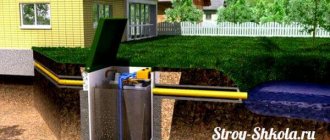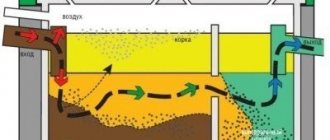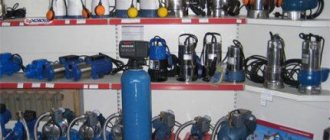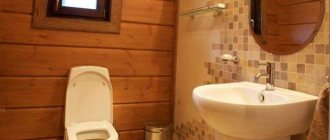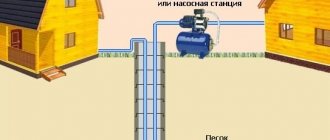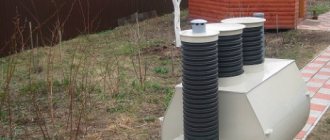What are septic tanks and what are they?
Some people mistakenly call a septic tank a complete set of treatment equipment. In fact, this is only part of the treatment facility, which acts as a storage tank and primary filter for wastewater containing a large amount of biomaterials that require disposal.
There are quite a lot of types of septic tanks created and each of them has its own pros and cons. Therefore, before purchasing, you need to take into account the soil on which the country house stands, the amount of water consumed and, of course, the budget that can be allocated for the purchase and installation.
Performance of septic tanks for summer cottages
The correct calculation of the performance of a septic tank is determined by the number of residents in the country. The resulting parameter is multiplied by 200 l - the standard regulating daily water consumption. It is also worth considering the possibility of guests arriving and determining the likelihood of installing a bathtub, dishwasher and washing machine.
The number of residents affects the design features of the septic tank. When planning to live with a small family in the summer, a storage device is quite enough. For a home with year-round use, an autonomous station is suitable. The number of chambers for a septic tank with soil filtration is also determined by the number of residents. A single-chamber structure will provide service for three people. It is preferable to divide the wastewater volume of 1-10 m3 into two tanks. Aeration stations cope well with large volumes.
Video description
For a brief overview of septic tanks for homes, watch the following video:
Septic tanks with a full cleaning cycle and a storage well for process water Source delfin.one
You can correctly decide which septic tank to choose - for year-round use or one that can work effectively even with periodic supply of wastewater on your own, since there is enough information. Many turn to the help of the Internet for such requests as rating of septic tanks for a country house 2021, to get acquainted with various ratings of septic tanks. But if you have doubts about the correct choice, then the best option would be to turn to professionals. They will take into account all the nuances and select the appropriate option, tailored to solve specific problems.
Operating principles of wastewater treatment plants
The range of autonomous sewers includes storage tanks, septic tanks for biomechanical wastewater treatment, and aeration systems. The first method ensures the separation of sewage into light and heavy fractions and water. Large inclusions settle at the bottom, light ones rise up, and water forms the middle layer. If there is an additional chamber, the liquid is re-settled and undergoes soil purification.
Filtration fields used by owners of septic tanks with soil post-treatment must be updated every 5-15 years. The need to replace drainage systems is caused by siltation of crushed stone, sand, and loss of the ability to filter wastewater. Associated costs include excavating backfill, removing soil, paying for disposal, and purchasing a new load.
In improved septic tanks (non-energy independent), wastewater passes through biofilters that decompose organic compounds into gas, water, and insoluble fractions. Solid particles settle at the bottom of the septic tank, compact and form sludge, which must be disposed of every 3-6 months. The gas passes into the ventilation system and exits through the drain pipe in the house. The clarified liquid is usually subjected to additional settling in the third chamber and disinfection with chlorine reagents.
Aeration systems are distinguished by the presence of compressors that supply oxygen with air to speed up the purification of wastewater by aerobic bacteria. Primary mechanical and anaerobic treatment is carried out in the receiving chamber of a volatile septic tank; the second unit provides the main processing of the liquid by microorganisms that neutralize organic compounds in wastewater. Air flows break up large inclusions and ensure continuous movement of particles. In further chambers, the waste water settles and is disinfected to 95-98%. Liquid is removed from the system by gravity or a forced pump. Aeration systems use energy sparingly, thanks to the presence of automation that starts devices strictly when needed.
Cleaning steps
Wastewater goes through several stages of purification in a septic tank:
- Stage of accumulation and settling. This stage consists of collecting waste in a special container, where it is separated into fractions by settling at a temperature of about 20 degrees. Solid particles fall to the bottom in the form of sediment, fatty deposits float to the surface, and fumes (carbon dioxide and methane) are removed through ventilation. At this stage, partial stratification of wastewater occurs, which is then sent to the next container;
- Secondary filtration stage. Its goal is to purify the mixture to approximately 75%. At this stage, the solution is purified using a separate filter consisting of a sorbent layer of about 20 centimeters. In some septic tanks, for proper operation, the sorbent must be washed and reactivated annually;
Stages of wastewater treatment in septic tanks Source mendig.ru
- Post-purification stage. Next, the water flows into the next specialized tank or a self-made soil filter, where it is finally purified. The purity of the water outlet here depends on the design of the septic tank.
Solid deposits settled in containers are pumped out with a pump or removed mechanically.
See also: Catalog of companies that specialize in water supply and sewerage.
Budget models
Septic tank TANK 2
This building has an ideal price-quality ratio. It accumulates, settles and treats wastewater. The structure is internally divided into three large sections, which are connected in series to each other. The last chamber is divided into two more. The latter contains a biological filter; it is used for anaerobic processing of wastewater. At the outlet there is another filtration system. Thanks to these design features of the unit, multi-stage cleaning occurs, due to which approximately 80% of pollutants are removed from the water. This is a fairly high figure. After the water leaves the chamber, it passes into the infiltrator, where the purification is fully completed, then it is discharged into the underlying soil layers or into the drainage ditch.
If the septic tank is designed for installation on the territory of a summer cottage, the most suitable design will be a design represented by one common building. It includes an outer casing, inside of which there are partitions with overflows, dividing the entire volume into two or three chambers. In addition to them, a biological filter with floating loading is provided. There are also two pipes - one for the inlet and one for the outlet; there are one or two necks that are tightly closed with special plastic caps. The maximum number of sections depends on how large the septic tank itself is. Small structures are equipped with two chambers, with their help up to 600 liters of water can be processed during the day; all other devices are divided into three compartments. The largest volume product can process up to 1200 liters of water per day, this volume is quite enough for a family of six people.
Advantages:
- The septic tank has a simple and reliable design that practically does not wear out;
- The housing is sealed and durable with reinforcing ribs, capable of withstanding significant loads;
- There are no elements that require regular maintenance or repair;
- You can choose the volume of the product depending on your needs;
- Long period of operation;
- The weight is small, you can install it even alone;
- Compact overall dimensions.
More: Where to buy Eurocubes?
TOP 5 companies in Moscow and the Moscow region Disadvantages:
- An additional sand or gravel filter must be installed at the outlet;
- Improper installation will result in an unpleasant odor in the house;
- Accumulated sludge must not be used as fertilizer in summer cottages or garden plots.
Septic tank TANK 2
Termite Pro 1.2
This unit accumulates and absorbs any contaminants quite efficiently, so it is quite acceptable to use purified water for technical needs, including for watering flower beds and even beds. The model is domestically produced and is manufactured in strict compliance with all construction and sanitary requirements, so the equipment does not cause the slightest harm to the environment. Wastewater passes through both mechanical and biological treatment. The model may have two or three compartments, through which the water is clarified and purified. Initially, the wastewater enters a storage chamber, where it settles so that all solid particles settle. Then they move to the bacterial filtration compartment, where special microorganisms living on special brushes remove most of the contaminants from there. Not all products are equipped with an additional settling tank; the wastewater is once again settled in it so that all remaining contaminants settle to the bottom in the form of sludge. All elements are connected to each other using special overflow pipes.
On the site, the structure will not take up too much free space; an empty septic tank weighs about 80 kg, so it can be installed manually. It is well suited not only for a country house, but also for a separate bathhouse. The structure is made of high-quality plastic, and the wall thickness is 20 mm. They are also equipped with stiffening ribs, so the structure can easily withstand even very severe physical loads. The product is easy to install and does not require additional maintenance.
Advantages:
- Not dependent on power supply;
- Resists pressure and serious temperature changes well;
- Easy to use;
- Durable model;
- The output is almost perfectly pure water.
Flaws:
- Manufacturers do not recommend installing the structure in areas close to the groundwater surface.
Termite Pro 1.2
MICROB 450
The company producing these products has been on the market for more than 25 years. During this time, the manufacturer managed to establish itself as a reliable manufacturer of sewerage equipment. Today the company is one of the leaders in terms of production of such devices. This small-sized model is perfect for a summer cottage where people live seasonally. The septic tank includes a plastic container, which is made on the basis of HDPE (low-pressure plastic), which can withstand moisture, low temperatures, pressure changes and other mechanical influences. Inside there is a receiving compartment where wastewater will flow, from which it passes into the second chamber, after first passing through a special filter. There is also a special ventilation outlet through which gases resulting from the activity of filter bacteria will escape.
Thanks to this device, it is possible to ensure a degree of water purification of up to 85%; to increase this indicator, experts recommend installing an infiltrator, but it will have to be purchased separately; however, according to users, you can instead assemble a drainage well with your own hands. Solid waste will accumulate at the bottom of the structure, so it will need to be pumped out periodically - once a year is sufficient. The manufacturer recommends using this design for a country house, since the model is capable of processing no more than 150-200 liters of wastewater per day. The structure weighs a little and can be installed alone. The total volume of the structure is 450 liters with overall dimensions of 0.81x4.13 m, its weight is 35 kg. It is one of the cheapest on the market.
Advantages:
- Small overall dimensions, allowing significant savings on installation;
- Easy to maintain, filters are very easy to change;
- Independent of electricity;
- Decent performance for its overall dimensions;
- High level of strength and durability of the product.
Flaws:
- Do not use too aggressive chemicals;
- Due to its light weight, it can float during spring floods - you have to additionally secure it in the ground.
MICROB 450
Rostok Mini
The most popular model in its price category. This design efficiently purifies domestic wastewater. Like most similar models, the unit is designed quite simply. It is a decent-sized tank, which is divided from the inside into two chambers. They are connected to each other using an overflow pipe; one of them has a special filter. The wastewater flows into the septic tank by gravity, without the use of a pump. The inlet pipe is equipped with a damper that prevents sediment accumulated at the bottom from rising. The first chamber is a settling tank and clarifier. Subsequently, the wastewater passes through mesh and sorption filters, which retain large contaminants. The latter is made from a special material - zeolite, and its thickness is 20 cm. After passing through them, no more than 20% of contaminants remain in the water compared to the original state. In this form, they can already go beyond the septic tank and undergo another additional treatment procedure. It can be a soil backfill or a special biological filter.
On sale you can find several types of such products, which differ from each other in volume - from 1000 to 3000 liters. You should choose depending on the number of people living in the house. The diameter of the inlet and outlet openings is 110 mm, which is quite suitable for standard sewer pipes. The inlet hole is 80 cm away from the top, and the outlet hole is 85 cm away. The model is characterized by ease of installation; there is no need to seek help from specialists. Water should be pumped out as needed - usually once or twice a year. The device does not take up too much free space on the site.
More: Top 10 best varieties of carrots, how to choose the most delicious varieties of carrots
Advantages:
- The body of the structure has no seams, which significantly extends its service life;
- There are stiffening ribs;
- Completely blocks unpleasant odors;
- Performance is small but stable;
- Does not require maintenance;
- Reasonable price.
Flaws:
- For its value it does not.
Rostok Mini
Operating principle
Technically, two types of waste disposal are used: anaerobic (without access of air) and aerobic (decomposition with the participation of bacteria that require oxygen for life).
Septic tanks have an anaerobic mechanism of action, which perform the functions of a storage tank or settling tank. Such purification systems, without installing additional equipment, only carry out primary clarification of wastewater and require frequent pumping with a sewer truck.
Important! According to sanitary standards, the discharge of liquid from anaerobic septic tanks into the soil is prohibited.
This option is suitable for rarely visited summer cottages or private houses with a small number of inhabitants. The cost of such a structure is low, installation does not require much effort, and operation does not require constant flow of wastewater into the chambers
The principle of operation of an anaerobic septic tank Source domvpavlino.ru
Colonies of active bacteria are often added to such septic tanks, which help process wastewater better than with conventional anaerobic treatment.
The aerobic process is carried out by local biological treatment plants. In such stations, colonies of aerobic and anaerobic bacteria effectively exist and interact, which purify wastewater more effectively.
Recycling is much faster, and the output water is practically non-toxic.
For the normal functioning of these septic tanks, the installation of aerators is required, which will saturate the wastewater with oxygen necessary for the life of aerobic bacteria. Also, aerobic systems must constantly work so that aerobic bacteria maintain their population and purify wastewater - if there is no oxygen supply, then anaerobic bacteria will begin to dominate over aerobic bacteria, absorbing them into food, as a result of which they will die and the station will switch to septic tank mode, where Only anaerobic bacteria will exist.
Obviously, the best septic tank for a country house is aerobic. But it all depends on the budget, since cleaning stations of this type are more expensive.
Scheme of operation of aerobic cleaning septic tank Source rinnipool.ru
Features of vertical septic tanks
The simplest septic tanks are simply a reservoir in which solid particles found in sewage settle, after which the final purification of the liquid in the soil occurs. These garden installations are inexpensive, but their productivity is low. They produce vertical septic tanks with several tanks, which significantly improves the quality of liquid clarification.
There are septic tanks that use deep cleaning technology, which purify the wastewater so much that after which the liquid is suitable for watering the garden area.
What materials are septic tanks made from?
An important aspect when buying a septic tank is the choice of material from which it is made. Most often, when ordering a ready-made septic tank, it is made from polymer materials.
In addition, the following materials are used for the manufacture of a local cleaning system:
- Metal constructions. Rarely used due to susceptibility to corrosion, general impracticality and inconvenience of use;
- Concrete. Monolithic structures are used as reservoirs. This option requires considerable investment of money and time; Mainly used when constructing septic tanks with your own hands;
- Fiberglass structures are the most suitable and frequently used material.
Also, septic tanks can be made from scrap materials (barrels, tires) yourself, but this option is only suitable for small country houses.
Homemade small septic tanks for a summer residence - from tires and concrete rings Source gameasphalt.ru
You can save on purchasing a cleaning unit by ordering from the manufacturer. The most expensive on the market are septic tanks with additional equipment for complete biological wastewater treatment.
Material of manufacture
Classification of treatment systems for dachas by type of housing:
Plastic, fiberglass types of septic tanks. The devices are industrially developed using durable polymer materials. They are attractive due to their tightness, low weight, ease of installation, avoiding the involvement of heavy equipment. Withstands aggressive environments for 50 years. Plastic retains heat, does not absorb moisture, and is resistant to soil pressure. However, the lightness of the structure increases the likelihood of extrusion during soil movements, destroying the sewerage system of a private house. Anchoring to a concrete bottom helps solve the problem.
Brick storage. When arranging a solid septic tank for a dacha, you will need pits of appropriate sizes, erect the walls in “one brick”, and waterproof the chambers inside and outside with cement mortar. Penetrating mastic will prevent the walls from getting wet from the outside. The arrangement of the system allows you to save on materials and perform a simple massage.
Reinforced concrete septic tanks. Key types of budget structures are represented by monolithic and prefabricated options. In the first case, the pit is filled with concrete, then the formwork is built. In the second, reinforced concrete rings are used for wells and the joints are sealed. Both options contribute to the creation of long-lasting treatment facilities.
Metal septic tanks. Creating chambers from expensive material that is susceptible to corrosion is an irrational way to build a treatment plant. Metal septic tanks are used extremely rarely in dachas.
Types of available materials used to create septic tanks: metal barrels, plastic containers with a volume of 200-250 liters, tires. Homemade septic tanks, composed of two chambers and filtration fields, can cope quite well with the volume of waste generated in the country when using a washbasin, showering no more than 3 people.
Volatile and non-volatile septic tanks
According to the degree of their autonomy, cleaning systems are divided into:
- Non-volatile (autonomous) septic tanks are settling tanks for the accumulation and clarification of wastewater. Such installations require periodic pumping of waste using a sewer truck. They have a low degree of purification and require additional ground filtration, for which it is necessary to allocate a plot of land. The positive aspects include low cost and independence from electricity;
- Volatile septic tanks are the complete opposite of non-volatile structures. Thanks to the design and additional equipment, wastewater in such systems undergoes a full cycle of processing and purification, which eliminates the need for maintenance. Disadvantages include their cost, as well as dependence on electricity. During a lack of power supply, the degree of purification of sewage water decreases, and the septic tank acts as a septic tank.
A pump and an aerator are mandatory components of a volatile septic tank Source bidinvest.ru
Rating of the best septic tanks
| Nomination | place | Name of product | minimum price |
| The best inexpensive septic tanks for a summer residence | 1 | ROSTOK MINI | 23 300 ₽ |
| 2 | DKS-OPTIMUM(M) | 22 000 ₽ | |
| 3 | Termite Pro 2.0 29 900 | 18 000 ₽ | |
| The best autonomous septic tanks | 1 | Tank | 19 800 ₽ |
| 2 | Tver | 67 500 ₽ | |
| 3 | Ecopan | 52 000 ₽ | |
| 4 | Triton | 21 500 ₽ | |
| 5 | Unilos Astra | 62 000 ₽ | |
| 6 | Termite Transformer | 31 500 ₽ | |
| The best volatile septic tanks | 1 | TOPAS | 74 500 ₽ |
| 2 | Eco-Grand (Poplar) | 76 500 ₽ |
Criteria for choosing a cleaning system for a country house
Before choosing a suitable septic tank, you need to consider the following aspects:
- The number of people living in the house - the power of the entire device depends on this;
- The material from which the septic tank is made determines its wear resistance and resistance to aggressive influences;
- The terrain where the structure will be installed and the height of groundwater;
- The complexity of installing a sewage treatment system - in terms of installation cost, septic tanks with a filtration field are in the lead, and the most profitable in this regard are biological treatment stations - their container simply needs to be buried in the ground;
- Own budget.
How to choose the right septic tank for a private home
Residents select autonomous sewers individually for the operating conditions in a particular house. Important criteria are:
- Groundwater level, soil composition. For difficult soils, structures reinforced with stiffeners are suitable. If the groundwater level is high, preference should be given to the appropriate connection height for the incoming pipe.
- Performance. The daily volume of wastewater discharged determines the performance of the septic tank. One person drains 200 l/day into the sewer. A small family of 3 people will need a device that processes 0.6 m3.
- The material affects the service life and reliability of the septic tank. Polymer is considered the best option due to its low weight and low cost design.
Important! The quality of the septic tank determines the comfort of living of the guests of a private house.
Popular factory-assembled septic tanks
To make it easier to decide on a suitable device, the following is an overview of septic tanks for a country house:
Sprout mini
A simple and reliable option for private homes. A capacity of about 200 liters per day is enough for stable operation of the sewage system when two people live in a house.
Septic tank "Rostok-Mini" in section Source stroychik.ru
It is entirely made of polymer material without the use of metal inserts and has a capacity of 1000 liters. The one-piece design of the cleaning system allows for complete tightness. Installation of this septic tank model will not cause any difficulties, since it weighs less than 3 kilograms and is cylindrical in shape. This design prevents groundwater from pushing it out of the soil while pumping out the contents. As for the cost, it is about 25,000 rubles;
Aster
This model of cleaning system is very popular on the Russian market. It can be classified as a premium type of septic tank. Such structures are made of polymer materials and have good performance indicators, since the throughput capacity is 1 cubic meter per day. Astra purifies wastewater at a high level, thanks to the presence of anaerobic and aerobic microorganisms and aeration. The option is designed for country houses where 2 or more people live. The disadvantages of such a cleaning system include its cost, which in 2021 reaches, for example, for 5 people - from 100,000 rubles;
Installed septic tank "Astra" Source apriltime.ru
Bioxi
It is a high-quality, energy-independent septic tank made of polymer materials, which is quite popular among domestic buyers. It has performance and throughput indicators similar to the Astra model. This cleaning system is equipped with a compressor that ensures the movement of wastewater through the system, as well as a special pumping unit that flushes the channels automatically. The disadvantages include, judging by the reviews of their owners, the frequent failure of additional equipment. The purchase price of such a septic tank is about 110,000 rubles;
Installation of a septic tank "Bioxy" Source instazu.com
The best storage type modification
Cumulative waste disposal units are in the least demand, since their operation requires regular cleaning. According to the principle of their operation, they are similar to cesspools. Among the most common filter equipment are Triton, Bars, and Rostok.
The best option for autonomous waste disposal units for facilities with high groundwater level
Some sites often experience heaving and high groundwater levels. This puts a lot of pressure on the body of the recycling equipment, so you need to choose a model that is strong enough. Among the most proven are Tver and Eurolos Grunt.
Types of domestic waste and the need for their treatment
Two types of wastewater enter the domestic sewer system:
- gray waste - contaminated water from kitchen sinks, washing machines, dishwashers, bathtubs and showers;
- black drains are organic waste from sanitary facilities.
It is estimated that the percentage of gray water by volume will be 70%, and organic matter 30%.
The lack of a centralized sewerage system forces homeowners to look for a way out of the situation, where the simplest option is to separate the drains with the installation of an external toilet and dig a well for gray water. Often such structures do not have a sealed bottom and the drainage goes directly into the ground, polluting the soil and shallow water layers; a sewer truck is ordered to clean the toilet and sewage pit. If in villages and houses in rural areas this practice is used everywhere, then near large cities in cottage villages such a violation of sanitary standards can be noticed by neighbors or sanitary services. In the absence of a centralized water supply, there is a high probability that wastewater can penetrate into the well or well of the cottage owner or his neighbors - this will lead to water contamination and possible poisoning, and the imposition of penalties. In addition, the lack of sewerage and the use of an external toilet worsens the comfort of living and forces homeowners to look for ways to independently treat sewage water.
Rice. 3 Tanks for septic tanks
Aerotank
This device differs from a septic tank with a biofilter in that the “working force” of the aeration tank is aerobic bacteria - that is, microorganisms that ferment in an oxygen-saturated environment.
Wastewater is pumped into the aeration tank by airlifts - special lifts that operate using compressed air.
Next, the wastewater is mixed with sludge, in which bacteria and protozoan microorganisms freely exist, and the oxidation process begins. Sewage and sludge are additionally mixed using aerators - special devices that add more oxygen to the water and speed up the process.
The effluent treated with sludge is transferred further. In the next section, the water is separated from the solid part of the wastewater and sent to the outlet. And the sludge that settles to the bottom returns back to the bacteria in the aeration tank.
Scheme of the Topas treatment plant
A septic tank with a biofilter has advantages over an aeration tank. Firstly, it does not work from the mains and does not depend on turning the electricity on and off. Secondly, it is more convenient to use: bacteria for the biofilter can simply be poured into the drain, and they themselves will find their way to their place of settlement.
The aeration tank is advantageous in that it does not need to be additionally insulated during the cold period, and wastewater treatment in it occurs faster and better than in a septic tank with a biofilter. Both types of bioseptic tanks require special maintenance. Be sure to call the sewer trucks once a year to pump out the sediment from their sedimentation tanks. In addition, the septic tank with a biofilter must be cleaned of excess bacteria, which can excessively silt the backfill. Dead sludge must be removed from the aeration tank. This procedure can be carried out independently: a special pump is built into the aeration tank system for this case. Airlifts and aerators also require annual cleaning.
Septic tanks with biofilters
A biofilter is a limited area in which bacteria live. This is usually a small tank filled with a chemically inert and rot-resistant substance called fill. Porous light substances such as shungizite, coke, nylon threads, polystyrene foam, and shell rock are used as backfill. Bacteria establish their colonies on such fertile material, visible to the naked eye as a thin film of silt.
In addition to this, the biofilter performs a mechanical barrier function. Its backfill retains large solid elements of wastewater.
Waste waste is converted into food for microorganisms. As a result of their vital activity, wastewater turns into sludge. It can be pumped out from a bioseptic tank and used along with other organic fertilizers.
Below the biofilter there is a container into which the wastewater flows after purification. In this last reservoir they are processed and can be discharged into the soil without further treatment. The processes occurring in the biofilter are identical to soil filtration of wastewater, with the only caveat that they proceed faster in the biofilter.
Parameters for calculating the volume of bioseptic tank
To calculate the volume of a bioseptic tank, you need to know two parameters: the number of its potential users and the salvo discharge.
The number of people who live in a private house should be multiplied by the average volume of water consumed per day per person - about 200 liters. More accurate data can be obtained by recording the water meter readings in the morning and at the end of the day.
The table below shows the average volumes of septic tanks, depending on the number of users.
The salvo discharge indicator indicates what is the maximum amount of wastewater that the bioseptic tank will have to accept at one time. To calculate it, you should add up the volumes of water consumption by all plumbing fixtures. The standards for each of them can be found in the table.
Advantages and disadvantages of bioseptics
The advantages of biological treatment stations include the fact that they:
- safe for the environment and do not pollute the soil, unlike soil filtration devices;
- easy to install and easy to use;
- durable, due to the absence of iron and other metals susceptible to corrosion in their design;
- reliable and compact;
- have high productivity;
- work equally effectively in any soil;
- They rarely require supervision or maintenance and are highly autonomous.
However, the following disadvantages of this type of septic tank can be mentioned:
- they are expensive and require maintenance costs;
- aggressive substances containing chlorine cannot be poured into them;
- they must be used continuously, otherwise the bacteria will starve to death.
What to consider when choosing?
To make the right choice of treatment plant, you need to consider the following factors:
- daily amount of waste;
- frequency of use (permanent, seasonal or periodic residence);
- features of the geology of the site;
- construction budget.
So, for a summer house used for periodic recreation, an inexpensive storage tank is quite suitable, but for a country house it is better to use more productive models - sedimentation tanks or biotreatment stations.
So, there are different types of septic tanks, so for any operating conditions you can choose the most optimal option. A properly selected and installed septic tank will last a long time, ensuring fairly high efficiency in the disposal of sewage wastewater.

